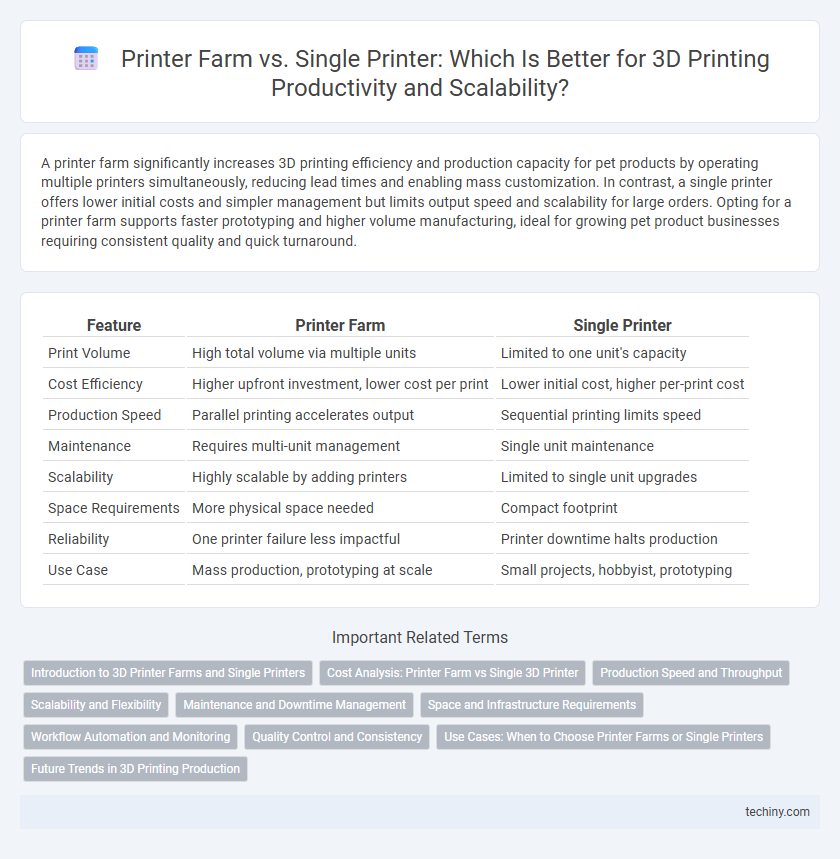A printer farm significantly increases 3D printing efficiency and production capacity for pet products by operating multiple printers simultaneously, reducing lead times and enabling mass customization. In contrast, a single printer offers lower initial costs and simpler management but limits output speed and scalability for large orders. Opting for a printer farm supports faster prototyping and higher volume manufacturing, ideal for growing pet product businesses requiring consistent quality and quick turnaround.
Table of Comparison
| Feature | Printer Farm | Single Printer |
|---|---|---|
| Print Volume | High total volume via multiple units | Limited to one unit's capacity |
| Cost Efficiency | Higher upfront investment, lower cost per print | Lower initial cost, higher per-print cost |
| Production Speed | Parallel printing accelerates output | Sequential printing limits speed |
| Maintenance | Requires multi-unit management | Single unit maintenance |
| Scalability | Highly scalable by adding printers | Limited to single unit upgrades |
| Space Requirements | More physical space needed | Compact footprint |
| Reliability | One printer failure less impactful | Printer downtime halts production |
| Use Case | Mass production, prototyping at scale | Small projects, hobbyist, prototyping |
Introduction to 3D Printer Farms and Single Printers
3D printer farms consist of multiple printers operating simultaneously to increase production capacity and reduce print times for large-scale manufacturing or prototyping. Single printers are ideal for hobbyists or small projects, offering flexibility and lower initial investment but limited output speed. Printer farms enhance scalability and efficiency through centralized management and automated workflows, making them essential for industrial applications.
Cost Analysis: Printer Farm vs Single 3D Printer
A printer farm offers economies of scale by distributing fixed costs like equipment maintenance and workspace across multiple machines, significantly reducing the cost per printed unit compared to a single 3D printer. Initial investment and operational expenses are higher for a printer farm, but bulk production lowers labor and downtime costs, optimizing cost-efficiency for large-scale projects. Single 3D printers incur lower upfront costs yet face higher per-unit expenses and slower throughput, making them less cost-effective for mass production scenarios.
Production Speed and Throughput
A printer farm significantly boosts production speed and throughput by operating multiple 3D printers simultaneously, enabling the completion of numerous parts in parallel. Single printers limit output to sequential printing, resulting in slower overall production cycles and reduced scalability. Utilizing a printer farm optimizes manufacturing efficiency, meeting high-volume demands more effectively than relying on individual printers.
Scalability and Flexibility
Printer farms offer superior scalability by enabling simultaneous production across multiple 3D printers, drastically increasing output compared to a single printer. Flexibility is enhanced as printer farms can handle diverse print jobs concurrently, optimizing workflow and reducing downtime. Single printers, while limited in scalability, provide ease of setup and may be more cost-effective for low-volume or specialized projects.
Maintenance and Downtime Management
In 3D printing, a printer farm significantly reduces downtime by distributing maintenance tasks across multiple machines, ensuring continuous production flow even if one unit requires servicing. Single printers demand more frequent halts for maintenance, directly impacting output and delaying project timelines. Optimizing maintenance schedules in printer farms enhances operational efficiency and minimizes costly interruptions.
Space and Infrastructure Requirements
Printer farms demand significantly more physical space and robust infrastructure, including enhanced power supply and ventilation systems, compared to a single 3D printer setup. Managing multiple printers requires organized layouts to optimize workflow and maintenance access, whereas a single printer occupies minimal footprint and simpler connectivity. Scaling production with a printer farm increases complexity in spatial planning and facility resources to support continuous operation and safety standards.
Workflow Automation and Monitoring
Printer farms streamline workflow automation and monitoring by enabling centralized control over multiple 3D printers, significantly increasing production efficiency and reducing manual intervention. Advanced software platforms provide real-time status updates, automated job queuing, and error detection across all printers simultaneously, minimizing downtime and maximizing output consistency. In contrast, single printers require individual supervision and manual job management, limiting scalability and increasing the risk of unnoticed print failures.
Quality Control and Consistency
Printer farms enhance quality control by enabling simultaneous production with standardized settings, reducing variability between prints. In a single printer setup, inconsistencies in temperature and calibration can lead to fluctuating quality across batches. Scaling with multiple printers ensures uniformity in output, facilitating more reliable consistency and faster identification of defects.
Use Cases: When to Choose Printer Farms or Single Printers
Printer farms are ideal for high-volume production environments requiring rapid output and consistent quality, such as manufacturing prototypes or batch productions. Single 3D printers suit low-volume projects, custom one-off designs, or detailed prototypes where precision and flexibility matter more than speed. Choosing between a printer farm and a single printer depends on production scale, budget constraints, and specific project requirements.
Future Trends in 3D Printing Production
The future of 3D printing production is increasingly favoring printer farms over single printers due to their ability to scale output, reduce lead times, and enhance efficiency in mass customization. Advances in automation, AI-driven workflow management, and cloud integration are streamlining operations within printer farms, enabling real-time monitoring and predictive maintenance. As industries demand faster prototypes and on-demand manufacturing, printer farms will become central to meeting volume requirements while maintaining precision and cost-effectiveness.
Printer Farm vs Single Printer Infographic

 techiny.com
techiny.com